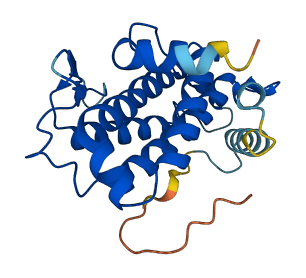Q9H8S9-1
Gene name |
MOB1A (C2orf6, MOB4B, MOBK1B, MOBKL1B) |
Protein name |
MOB kinase activator 1A |
Names |
Mob1 alpha, Mob1A, Mob1 homolog 1B, Mps one binder kinase activator-like 1B |
Species |
Homo sapiens (Human) |
KEGG Pathway |
hsa:55233 |
EC number |
|
Protein Class |
MPS ONE BINDER KINASE ACTIVATOR-LIKE MOB (PTHR22599) |

Descriptions
Mob1 is an activator of LATS1/2 in the Hippo signaling pathway which plays a pivotal role in organ size control and tumor suppression by restricting proliferation and promoting apoptosis. Mob1 adopts an autoinhibited, closed conformation, with its N-terminal FXFx5KxF motif. Phosphorylation of Mob1 at T35 relieves this autoinhibition and stimulates Lats1 binding in part.
Autoinhibitory domains (AIDs)
Target domain |
31-204 (Mob1/phocein family) |
Relief mechanism |
PTM |
Assay |
Structural analysis, Deletion assay |
Accessory elements
No accessory elements
References
- Ni L et al. (2015) "Structural basis for Mob1-dependent activation of the core Mst-Lats kinase cascade in Hippo signaling", Genes & development, 29, 1416-31
- Stavridi ES et al. (2003) "Crystal structure of a human Mob1 protein: toward understanding Mob-regulated cell cycle pathways", Structure (London, England : 1993), 11, 1163-70
Autoinhibited structure
Activated structure

12 structures for Q9H8S9-1
| Entry ID | Method | Resolution | Chain | Position | Source |
|---|---|---|---|---|---|
| 1PI1 | X-ray | 200 A | A | 33-216 | PDB |
| 4J1V | X-ray | 195 A | A/C | 33-216 | PDB |
| 4JIZ | X-ray | 210 A | A | 40-211 | PDB |
| 5BRK | X-ray | 230 A | A | 1-216 | PDB |
| 5BRM | X-ray | 265 A | A/B/C/D/E/F | 41-216 | PDB |
| 5TWF | X-ray | 314 A | A/B | 1-216 | PDB |
| 5TWG | X-ray | 230 A | A | 1-216 | PDB |
| 5TWH | X-ray | 250 A | A | 1-216 | PDB |
| 5XQZ | X-ray | 210 A | A/B | 33-216 | PDB |
| 6MCP | X-ray | 250 A | B/D | 33-216 | PDB |
| 6MCQ | X-ray | 257 A | B/D | 33-216 | PDB |
| AF-Q9H8S9-F1 | Predicted | AlphaFoldDB |
No variants for Q9H8S9-1
| Variant ID(s) | Position | Change | Description | Diseaes Association | Provenance |
|---|---|---|---|---|---|
| No variants for Q9H8S9-1 | |||||
No associated diseases with Q9H8S9-1
No regional properties for Q9H8S9-1
| Type | Name | Position | InterPro Accession |
|---|---|---|---|
| No domain, repeats, and functional sites for Q9H8S9-1 | |||
Functions
| Description | ||
|---|---|---|
| EC Number | ||
| Subcellular Localization |
|
|
| PANTHER Family | PTHR22599 | MPS ONE BINDER KINASE ACTIVATOR-LIKE MOB |
| PANTHER Subfamily | PTHR22599:SF30 | MOB KINASE ACTIVATOR 1A |
| PANTHER Protein Class |
kinase modulator
kinase activator |
|
| PANTHER Pathway Category |
CCKR signaling map MOB1 CCKR signaling map MOB1 |
|
4 GO annotations of cellular component
| Name | Definition |
|---|---|
| cytoplasm | The contents of a cell excluding the plasma membrane and nucleus, but including other subcellular structures. |
| cytosol | The part of the cytoplasm that does not contain organelles but which does contain other particulate matter, such as protein complexes. |
| extracellular exosome | A vesicle that is released into the extracellular region by fusion of the limiting endosomal membrane of a multivesicular body with the plasma membrane. Extracellular exosomes, also simply called exosomes, have a diameter of about 40-100 nm. |
| nucleus | A membrane-bounded organelle of eukaryotic cells in which chromosomes are housed and replicated. In most cells, the nucleus contains all of the cell's chromosomes except the organellar chromosomes, and is the site of RNA synthesis and processing. In some species, or in specialized cell types, RNA metabolism or DNA replication may be absent. |
2 GO annotations of molecular function
| Name | Definition |
|---|---|
| metal ion binding | Binding to a metal ion. |
| protein kinase activator activity | Binds to and increases the activity of a protein kinase, an enzyme which phosphorylates a protein. |
2 GO annotations of biological process
| Name | Definition |
|---|---|
| hippo signaling | The series of molecular signals mediated by the serine/threonine kinase Hippo or one of its orthologs. In Drosophila, Hippo in complex with the scaffold protein Salvador (Sav), phosphorylates and activates Warts (Wts), which in turn phosphorylates and inactivates the Yorkie (Yki) transcriptional activator. The core fly components hippo, sav, wts and mats are conserved in mammals as STK4/3 (MST1/2), SAV1/WW45, LATS1/2 and MOB1. |
| positive regulation of protein phosphorylation | Any process that activates or increases the frequency, rate or extent of addition of phosphate groups to amino acids within a protein. |
No homologous proteins in AiPD
| UniProt AC | Gene Name | Protein Name | Species | Evidence Code |
|---|---|---|---|---|
| No homologous proteins | ||||
| 10 | 20 | 30 | 40 | 50 | 60 |
| MSFLFSSRSS | KTFKPKKNIP | EGSHQYELLK | HAEATLGSGN | LRQAVMLPEG | EDLNEWIAVN |
| 70 | 80 | 90 | 100 | 110 | 120 |
| TVDFFNQINM | LYGTITEFCT | EASCPVMSAG | PRYEYHWADG | TNIKKPIKCS | APKYIDYLMT |
| 130 | 140 | 150 | 160 | 170 | 180 |
| WVQDQLDDET | LFPSKIGVPF | PKNFMSVAKT | ILKRLFRVYA | HIYHQHFDSV | MQLQEEAHLN |
| 190 | 200 | 210 | |||
| TSFKHFIFFV | QEFNLIDRRE | LAPLQELIEK | LGSKDR |